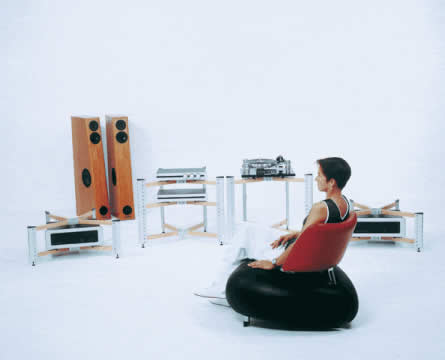
Product: Spider
Manufacturer: Finite Elemente
Homepage: www.finite-elemente.de - Germany
Price: variable (see Configurator in the Homepage)
Reviewer: Mattia Bellinzona - TNT Germany
Reviewed: June, 2004

Introduction
The function of a hifi rack is quite simple: to hold your hifi components while isolating them from any interference. It sounds simple but it is actually impossible unless you float the components in space. The solutions to this basic problem are sometimes bizarre, exotic, ugly, absurd or very expensive.
An unstable base…or the Pisa approach
Let us start in order and design something clean and simple: we could place
everything on the floor. No rack, no (rack-related) problems. But this requires
you to take up huge surfaces for a few units and it will be very incovenient
for anybody to operate (the floor is lower than your back). So we all agree
that some kind of a table is needed, and this is where the problems begin...
Legless isn’t good for you
Some argue that three legs are better that four, based on sound geometrical
evidence. Although this is true, four legs can work just as well and allow
better weight distribution leaving the back of the components free. The so
called third leg will do fine if placed on the side (as in the TNT Flexi
design) although producing an unequal weight distribution, but if it it is
placed at the back (as with most commercially available racks) it will disturb
cables.
Inside a drum
Our Editor has already expressed his concern about closed racks and their ability
to resonate with the music. There are many solutions but just one Spider!
Less is more
The idea behind the Spider is simple: four legs connected by four arms that
come together in the middle attached to a star-shaped metal crown. There
are no separators. Therefore the closed box effect is avoided at source.
The Spider sits on spikes. Finish is excellent, legs and connecting “star” are
in polished alu-look, the connecting arms are in wood available in several
colours.
 Modulus
Modulus
To understand the Spider one has to understand the modular concept behind it.
Its legs are made of metal, have an asymmetrical section and holes to connect
with the arms (with screws). The holes are at regular intervals and allow
very flexible placement of the arms, depending on the size of the HiFi components.
If you have a Spider with 60cm legs (!) you can place a number of components
depending on their size. If you were to change any of these you could easily
readjust the Spider to the new measurements.
At one end of the legs spikes can be connected, although even wheels are available
(not all FE clients are audiophile freaks, I guess). The other end can be connected
to another leg element with a robust connector. This can go on forever until
you have the desired leg length. The four arms are simply wooden elements that
are screwed onto the legs and at the other end to the central star-shaped metal
part. And here comes a simple but clever trick. Since the arms are of different
lengths and can be connected to the central star at different angles one can
actually produce a variable holding surface with different lengths and depths.
Any shape and weight can be accommodated, now or in the future. The racks that
I know do not allow for this kind of flexibility.
Floating elements
I never spoke about separating planes because the components are directly placed
onto the arms on robust rubber feet. No holding surfaces mean no resonances
(at least those due to them…). The overall structure is simple, robust,
effective and elegant.
Tips and tricks
No separators can become a problem if one component at the bottom of the
rack gets very hot (like a big amp) so you may want to add a surface to insulate
the component above. I had to do this to protect my CD player. The same is necessary
for a turntable on spikes. The Spider can hold up to 50 Kg/level, I put over
100 Kg on three levels.
It may look difficult to decide which Spider model suits your needs, therefore the manufacturer has a “configurator” on its homepage that gives you the exact code you need to order given the size and number of the components you have.
An ecological highlight: the packaging is precise and elegant. Everything can be recycled if you send it back to the company. If you plan to move you should keep the packaging as there is no better way to store your Spider.
Advantages
-unprecedented modularity
-original looks
-upgradeable
-very robust
Disadvantages
-sharp edges (baby at home?)
-not economical
Conclusions
The Finite Elemente Spider works like a spider’s web. It looks wonderful
and it completely eliminates closed rack resonances. Its flexibility justifies
its price. One can always add an element or modify the structure without having
to change everything while its attractive metal/wooden finish makes the Spider
easy to integrate with its surroundings. Several more exotic racks are available,
some making use of the most complex antiresonance solutions and they are often
very expensive. The Spider looks like a naked tree which can do one amazing
thing: let your precious HiFi sound-machines float into the Music.
© Copyright 2004 Mattia Bellinzona - www.tnt-audio.com